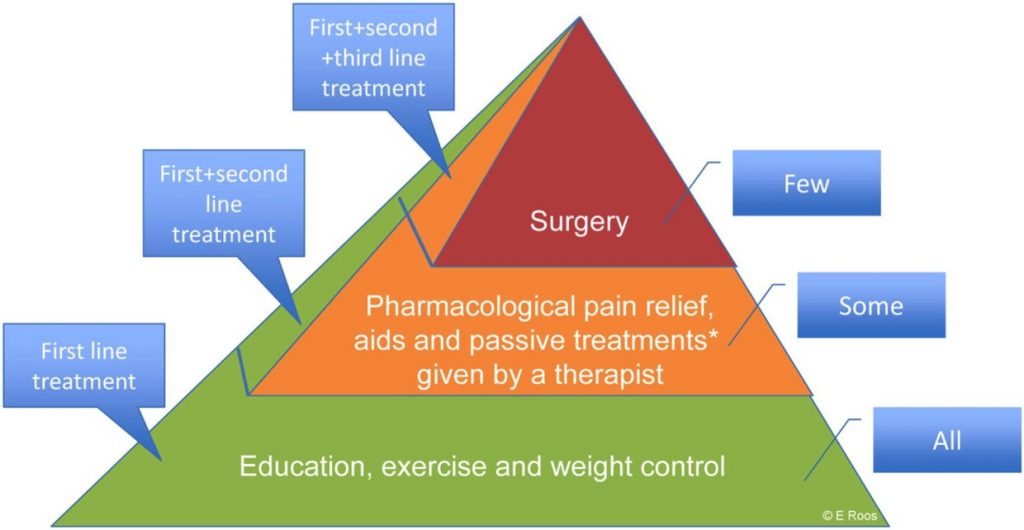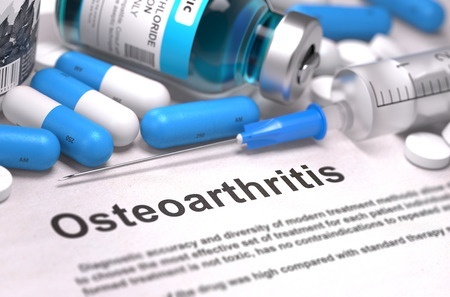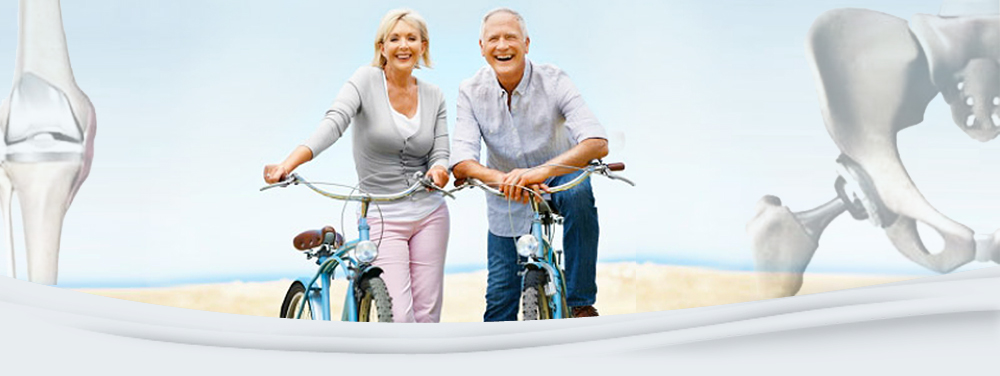TREATMENT FOR OSTEOARTHRITIS
Currently, there is no known way of curing cartilage loss. Treatment is used to reduce symptoms and improve function of the joint. Learning about osteoarthritis is part of the treatment. Special exercises can be done to relieve pain and boost joint function. When function improves, the next step is to get more active. Being physically active can help maintain weight loss and improve overall health. These things should be done as early as possible by people who have osteoarthritis. Management of osteoarthritis symptoms can be viewed in the pyramid below, in which the lower part is made up of information, exercise and weight reduction (if necessary). This should be offered to all who have osteoarthritis, as early as possible.

Level 1 – Minor symptoms

All individuals who have started to experience the symptoms of osteoarthritis, such as clicking, and those who are at high risk of developing osteoarthritis should receive some intervention to prevent the potential progression or development of symptoms. This intervention should include information about the disease, training to promote joint stability, the need to continue to promote joint stability in daily physical activity and weight reduction as necessary.
Education
It is important that everyone with osteoarthritis is provided with the basic information about arthritis. Learning about the condition is a good way to improve knowledge and confidence in one’s ability to manage it. Osteoarthritis often results in pain which can lead to individuals reducing their physical levels of activity. However, it has been shown that reduced strength in the muscles can actually increase the symptoms. Therefore, maintaining a level of physical activity is important and will result in reduced fear of movement, increase motivation to exercise and improve one’s health and quality of life. Supporting and helping someone with this condition to exercise can help improve their health and wellness.
Exercise, physical activity and joint stability
Exercise has been shown to be the best treatment for people who have trouble with their osteoarthritis. Exercise reduces pain and makes it easier for people to do their daily activities. Being active can lead to lots of positive things like a strong heart and good overall health. It is easier to control your weight with exercise compared to without exercise.
Weight control and reduction
Obesity is an increasingly common problem and is a known risk factor for many diseases, including osteoarthritis of the hip and knee. For people who are overweight, the load on the joint is much more (two to three times greater) than the actual amount of body weight applied. This means even a small difference in body weight can greatly affect the load on the joint. Being overweight is also linked to changes in metabolism (rate of chemical reactions in your cells), which may be linked to osteoarthritis in the hands. Obesity is also linked to faster breakdown of cartilage. Losing weight is important for lowering pain and improving function for those who are overweight.
Level 2 – moderate symptoms

When an individual is experiencing moderate symptoms, the first line of treatment is to undertake the strategies identified above including education, exercise and weight control/ loss. Where the condition has progressed and these strategies are not controlling symptoms, medications and assistive devices such as walking aids and insoles can be used in addition to exercise.
Medication
There are a number of medications that can be used to manage symptoms associated with OA. Some of these can be purchased over the counter and some require a physician’s referral. In some cases the medications are taken through the mouth, in some cases rubbed onto the joint and in some cases they are injected into the joint. This section provides some basic information about medications. All individuals are encouraged to speak to their primary care provider regarding their medication use. Medications should be taken as prescribed and with an understanding of the potential side effects.
Acetaminophen (for example Tylenol) is usually the first choice for pain relief for osteoarthritis. It gives the fewest side effects and can be used as needed. Too much can damage the liver, therefore you should not go over the prescribed dose.
NSAID / COX-inhibitors (for example Ibuprofen, Motrin, Advil and Naproxen) can be used when Acetaminophen is not working well enough. These can also be used if the joints are hot and swollen. These drugs control pain, swelling and stiffness but may cause side effects.
Corticosteroid injection (cortisone) may also be used if the joint is hot and swollen. This can decrease pain in 1-4 weeks. Research has not found any long-term effects from corticosteroid injections.
Glucosamine and/or condroitin sulphate are found naturally in the joints. They can be found in foods and through supplements. More research is still needed to know if some individuals will benefit from glucosamine and/or condroitin sulphate supplements. Currently, groups of people taking these supplements do not benefit more than people taking a placebo or sugar pill. To see if either of these supplements might work for you, try taking it for six weeks without changing your daily routine. Stop taking the supplement after six weeks. If you felt better while taking the supplement than since stopping, it may be working for you.
Assistive devices
There are a number of aids that can be used to assist individuals with osteoarthritis who are experiencing significant pain and disability. They include:
- Shoe inserts that change the weight bearing patterns through the leg can off load the knee thereby reducing symptoms
- Braces, such as knee braces, which wrap around the joint to help to stabilize it and decrease some of the load going through the joint
- Walking aids can be used by individuals who are limited in their walking related to the pain and disability within their hip or knee joints.
Level 3 – Severe disease
 For individuals who are experiencing severe disease that is causing them sufficient pain and disability limiting their daily physical activity, surgery is an option that may be considered.
For individuals who are experiencing severe disease that is causing them sufficient pain and disability limiting their daily physical activity, surgery is an option that may be considered.
Arthroplasty/Joint replacement
Arthroplasty is the name for joint replacement surgery in which the failed joint is removed and replaced with artificial joint surfaces of metal and plastic. This is a common procedure for people with severe hip and knee osteoarthritis. The biggest gain after the surgery is that the pain diminishes or disappears completely. Following the surgery, range of motion in the joint is still slightly limited.
Osteotomy
In people with severe deformity, such as knock-knee or bow-leg, where only one part of the knee has thin or no articular cartilage, (the other joint compartment or part of the knee joint is healthy and normal), an osteotomy might be beneficial. A wedge-shaped part of the bone of the lower leg is removed in order to change the load through the knee. The compartment of the knee relatively unaffected by the osteoarthritis takes more load. Once the wedge is removed, the surgeon uses a metal plate and screws to support the bone so that it heals properly.
Additional treatments
There are some additional treatments that may help you in managing your osteoarthritis symptoms including:
- Hot/cold packs
- TENS (Transcutaneous Electrical Nerve Stimulation)
- Acupuncture
If these treatments help you to control your pain your GLA:D™ Australia trainers may be able to build them into you program while you exercise to maximize the benefits in gaining joint stability.
